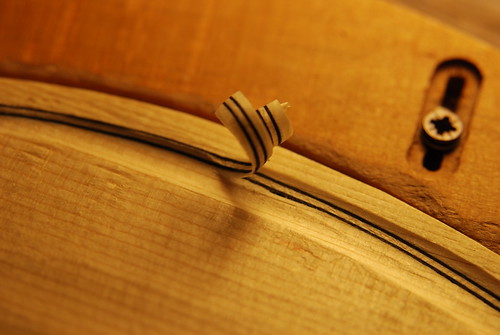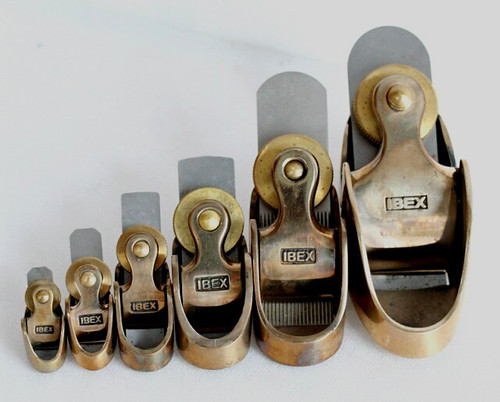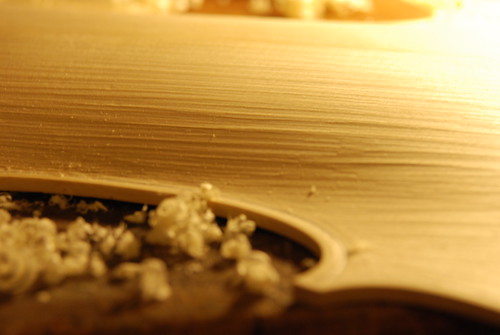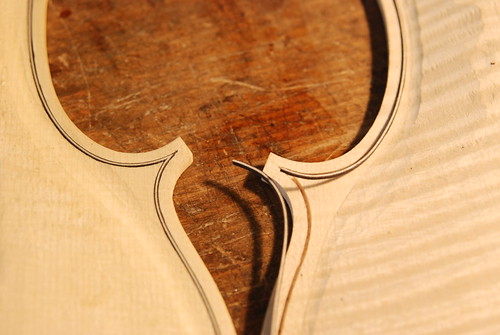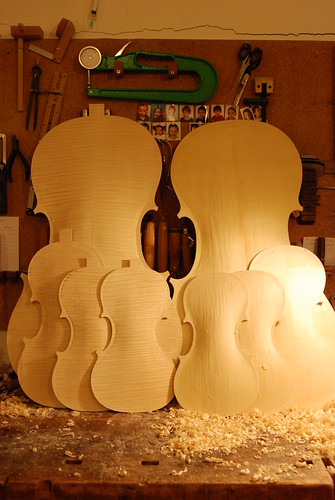
April 2012
Violin Maker's Wife: Bombatura!!
April 30, 2012 12:04
Post No. 11
Don’t you just LOVE Italian? I guess by now even the slowest-witted person could figure out that I do. Very much so. The first time we went to Italy, when Yonatan was still in his architectural period, we were invited to spend a year with two Italian architects working in Friuli, an Italian province bordering with Slovenia, on restoration of mediaeval castles. Getting ready for this adventure, we took a very basic course at the Italian Cultural Institute in Tel-Aviv. The teacher, who we still fondly recall, walked into the classroom and started to speak fluent Italian – explaining to us what the course will be about, what she wanted us to do etc. For a few minutes we were all dumfounded, but then gradually we saw that if we just listened to the music of the language, together with the expressive body language the teacher helpfully used, we could actually figure out what she was saying. Ever since then, I fell in love with Italian.
As you may know, Italians speak basically only Italian, (that includes university professors, employees of international companies, and tour guides working in the Tourist Information Offices…), so we had to learn fast. Real fast. Over the years we have gradually moved from basic stuttering – just to be able to buy tomatoes at the market, to basic conversational skills – which I had to develop very quickly I order to communicate with my son’s kindergarten teachers, to almost fluent Italian. Still, there comes a wonderful word like “Bombatura” and blows me away….
Bombatura is one of the most important processes in making a stringed instrument, by which the rough arching carved from the blocks of wood that will become each instrument’s front and back, is painstakingly carved and shaped into the final arch that defines the instrument’s body, volume and character. While the mold helps shape the contours of the violin, it is two-dimensional by definition, and so there is actually nothing but the violin-maker’s eye that helps mark, shape and sculpture the instrument’s arching.
Yonatan loves this part of the process the best – exactly because he is not constrained by a model (even not by his own model…), and needs to use his eyes’ extraordinary ability to three-dimensionally-imagine what the violin (viola… cello…) will look like.
So first, as I mentioned last time, the “sguscia“(sgoo-sha, or fluting in English) is done, in which a shallow canal is carved over the Purfling:
From this canal, the arching of the entire back and front piece begins to rise. At first in a rather rough form, using increasingly smaller and more exact gauges:
Then, when the general shape of the instrument’s body has been sculptured – because honestly more than anything else, this phase involves sculpturing the wood into the carved, unique, hand-made shape that will give the instrument its body and character – the really exact tools come into play. Yonatan uses special planes called “thumb planes”, which look more like Jewelry than like wood-working tools, and come in numerous sizes.
Up until recently…well, actually up until a few minutes ago, I thought the difference was that the smaller the thumb-plane was, the more delicately it scraped, and the finer the trucioli that it produces. Well, let me tell you, when I said this, Yonatan gave me the most incredulous, condescending look. He explained that “obviously” that’s not the case, and the difference is that you can use the larger planes on the larger instruments, where the curves are much wider. The smaller and more exact planes are used to follow the curves of the smaller instruments in the quartet. Of course! Silly me! I guess this stuff should be basic pre-marital education for any and all violin-makers’ wives…
So finally – one last picture of the way the cello, the viola and one violin look by now, ready for the very last phase of the Bombatura process – what, did you really think that’s it?? – which I’ll write about next week.
Violin Maker's Wife: Purfling Part II
April 22, 2012 05:36
Post No. 10
By now all the canals have been cut around the four instruments, and now comes the really tricky part: the “filetto” needs to be inlayed. First, it must be cut to exactly fit the corners. How exact? Well, the end of each strip is cut not straight but a little diagonally, and at every corner, two pieces must meet so very exactly that they form a perfect triangle: each tiny black strip (one-third of the wooden strip, remember?) has to meet its mate in the adjacent strip, while the while strip in the middle must meet its mate, and thus – if this mastery is done right, (sort of “a perfect kiss”), it appears that a single piece was used throughout the process.
I remember the first few times Yonatan and his classmates had to do this back at the Stradivari School in Cremona, it took them many many trials and errors to get all these “exactlies” just so… Now, many instruments later, it is almost routine, but still – the way the purfling is done defines the final contour of each instrument and the way the filetto pieces fit together at the corners is one of the best indications of a violin maker’s technical ability, attention to minute details and personalized style. Yonatan, for example, likes to use thin strips and to keep the ends of the corners long so that a piece of the filetto continues beyond the corner, like an ornament.
Why go through all this trouble you may be asking yourself? That is, what’s the use of all this filetto-contour? Well, as is often the case with violins (and violin makers) the answer is complex – it is a combination of a technical function as the filetto helps strengthen the resistance of the instrument’s front and back against cracks that might form along the wood fibers; and sheer aesthetical function, beautifying the instrument. This constant interplay between functionality and aesthetics is one of Yonatan’s favorite aspects of violin making.
Anyway – when all the instruments have been inlayed with purfling front and back, a new phase begins, called “fluting”. Here a chisel is used to carve a shallow canal that cuts through both the instrument wood and the purfling, until finally it really looks like the black lining was drawn rather than inlayed. You’ll see next week that this canal is the first step in carving the external arching of the instrument.
As is my habit once in a while, just to keep him on his toes :), I made a surprise visit to Yonatan’s workshop today, to see how he was doing …or actually how “my quartet” (becoming possessive here…) is doing. I found him hard at work carving the fluting on the cello. Here you can see how it’s done.
…and here you can see all four instruments with the purfling finished. Yonatan attached the cello back to the mold with special clamps. For a moment I thought he had glued it already (and without telling me, can you imagine the audacity?), but he calmed me down saying that he only fixed it in place because if you leave such a large, arched piece of wood lying around it is bound to bend out of shape (literally, that is) due to humidity and temperature changes.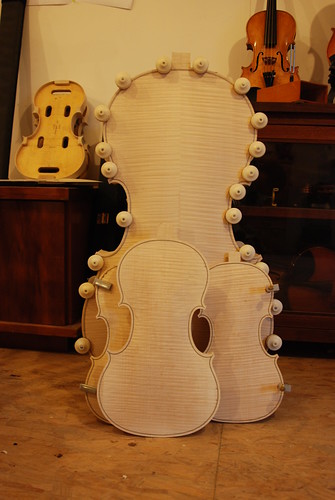
We have less than six months remaining… and while a significant portion of the work is already complete, there’s still a long way to go.
Stay with us!
Violin Maker's Wife: Purfling Part I
April 13, 2012 02:59
Post No. 9
The corners have been carved, shaped and completed, and Yonatan has invested this past week in the process of Purfling. If shaping the corners is one of the most challenging steps in terms of coordination and personal artistic touch, then Purfling must be the most challenging step in terms of technical ability.
You know how violins, violas, cellos and double basses have a black line going around their contours? Well, what looks like a “line” is actually the result of a thin canal that was cut out around the contour of each instrument’s front and back, into which a thin, flexible strip of wood was inlayed. This strip is itself composed of three thin slices of wood that look like a sandwich – two strips of blackened wood with a strip of white wood in the middle. This strip – “filetto” in Italian, which means “thread” – varies in width according to the size of the instrument.
Just to give you an idea how thin it is, well, in a violin it’s about 1.2 mm wide (that’s a bit over 0.04 of an inch for all you Americans out there!). And thus the Purfling process – cutting out the canal and inlaying the wooden strip – is called “filettatura” (pronounced fee-le-ta-too-ra, with the accent on the “tu“). Sorry – but it always does sound better in Italian….
As a first step, the canal is cut out around the instrument’s contour. It must be cut out at an equal distance from the edge and remain exactly as wide as the wooden strip that will then be inlayed – throughout its entire length. The tricky part, as always, is at the corners themselves, where no instrument can be used to draw the line other than the human eye. Yonatan says “it’s like drawing a line with the knife” – only no erasing is possible, is it?
That’s what Yonatan has done this week for two of the violins and the cello, and the viola, as always, was the last one to go. Working on the filettatura with a special set of extremely sharp knives is hard enough for a single instrument; doing one instrument after another – well, this is part of the challenge of creating an entire quartet at once!
You think that’s tough? That’s actually the easy part. Once this part is complete, the “filetto“, which Yonatan buys in long strips every time we travel to Italy, needs to be cut and inlayed, and this will happen next week so you’ll just have to wait and see, won’t you:)
Can I use the few lines I have left to tell you something completely unrelated? So, yesterday was Saturday and we went with the kids to visit the new (and first ever) home we bought. It’s in a different town, about 20 minutes away from the one we currently live in, and since we finally got the key a couple of weeks ago, we try to drop by every weekend to help the kids (and ourselves…) become friendly with this new home. Anyway – the house currently stands bare and empty, awaiting renovations. It was pretty cold (in Israeli standards) so we decided to check if the old, cast-iron wood stove the previous owners left behind works. We found a pile of old pieces of wood outside that remained in a dry corner notwithstanding all the rain, and wondrously enough, had a happy warm fire burning in no time.
We brought over a blanket from the car, and while little Alona (a year old this past month) fell asleep near the warm stove, Yonatan and the kids went to get take-away burgers, which we ate right there on the floor, in our new, totally empty house, in front of the burning fire.
Do you, too, get the feeling WOOD plays a major role in our lives??…
Violin Maker's Wife: Putting the Corners in the Center
April 5, 2012 05:14Post no. 8
After days of hard work, the four instruments are taking their final shape. Yonatan finished roughing out all four external arching, as well as completing the flat contours, and over the past few days has been concentrating on completing what is one of the most important – and personalized – aspect of violin making: the corners.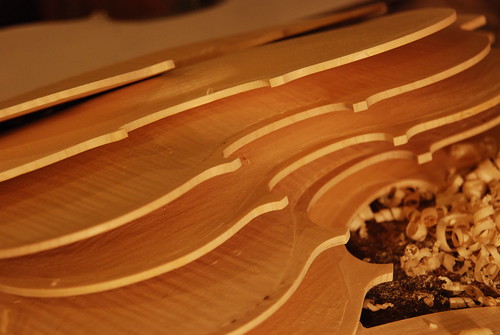
You know, when most of us mortals (that is, non-violin-makers) think of a corner, we think of an out-of-the-way, often insignificant aspect of a room, a structure, or even a situation. But for a violin maker, shaping out the corners of an instrument is a most central task; a creative challenge that’s an opportunity to bring to light a unique personal touch. You may ask why the corners are so important if the models of the instruments were prepared so long ago, based on classical, often pretty rigid, measurements. Well, the answer is that the model of a violin creates its general shape, but the mold really only lays out the contours of the sides, the top and the bottom. The corners, however, are a “free-standing” component – meaning that they are external to the mold, and each violin maker can shape them based on his or her own esthetics. And here’s the real challenge: this is done based on hand-eye coordination, with no external assistance. Although the basic proportions of the mold are maintained, changes in the corners alter the entire “look” of the instrument. As is the case with almost every step in the violin-making process, this is a one way trip – once you have sculptured a piece it cannot be put back so every error is irredeemable.
I must tell you, being someone for whom drawing a straight line is a real challenge (and I mean WITH a ruler in hand), I can’t imagine how he manages to shape these corners based on his mind’s vision only, and then how he makes the wood bend to his will and become that shape… But, being the true artisan that he is, this is one of Yonatan’s favorite steps. The way he described it to me “the corners actually define the instrument’s outline. They are the place that all the lines of the instrument flow into; they are the aspect that most draws the eye of the looker; and they are the place where I can add my personal touch to each model, creating the harmonic shape I wish for each instrument”. Now tell me that’s not poetry…
So basically, once the instrument’s corners have been finished, the external contour takes its final shape, and the instrument is ready for the next phase called purfling (a word even my Word Dictionary doesn’t recognize…), of which I’ll write next week.
And here we are. Look at the following pictures: all the endless quantity of trucioli has been cleared aside (a portion of it Yonatan collected and brought a huge sack for our daughter Yaara’s kindergarten to use as materials for their artistic activities). Now that all four instruments have taken their final outline, it’s really impressive to look at all of them together –
If you look on the wall behind the instruments you can see passport pictures of our kids that Yonatan has been collecting since they were born (thanks to the unparalleled Italian bureaucracy there are many of those) , and these pictures are overlooking the entire scene.
Wow – now that I am looking at this last picture, it looks like two parents with… let’s see… six kids (!!). Well, let me tell you, that ain’t going to happen here! Then again, maybe this is just my private association since it’s Family Day in Israel today:)
If you want to see more of these terrific pictures, look in the Quartet Slideshow!!.
Violin Maker's Wife: A Scene with a Viola, A Story of a Double Bass
April 1, 2012 11:24Post No. 7
This week I have decided to take a pause from covering the construction of the Quartet. No, don’t worry, nothing is wrong – Yonatan is just still working on finishing the borders of the cello and the two violins, while the “left-behind-viola” is still untouched and needs to go through the “sgrossatura” process. In the meantime, though, I have a beautiful scene to describe and a great, true story to tell you:
So here is the scene that was played out (literally) at our home yesterday evening: Galia, Yonatan’s viola-playing sister, came over for dinner. Right on time, too, as Yonatan just finished putting the strings on her new, gorgeous viola (which, as you, Attentive Readers may recall, he had built especially for her). So now please picture this: Galia is sitting on our sofa, with the new, shining viola to her shoulder, playing for us the first notes this instrument has ever sounded – and it sounds amazing! The two of us and our three kids are all gathered around her, and even our not-even-one-year-old baby Alona is mesmerized by the sound this viola is making.
To make the viola unique, Yonatan chose very unusual keys for it. Unlike most keys, made of ebony, these are pure maple wood, and they have tiny shining stones embedded at their tips, which might sound awfully kitsch, but turns out to be very chic instead. Now Galia needs to play the viola for a while to “warm it up” and “open it”, as both violin makers and musicians like to say. One of the amazing facts about these instruments is that although the wood they are made of appears to be dead, it remains a living substance that is affected by the vibrations passing through it as music is played. The wood actually changes over time and instruments sound much better – warmer, more vibrant, more powerful and pliable – after they are played for while (musicians even claim it is also important who plays the instrument; and that a different touch on a new instrument would ultimately result in a different sound). I promise to report and send pictures from the first début of Galia’s new viola on stage!
…And here is a great story I have been wanting to share with you of how we brought the double-bass Yonatan had built in Italy, back to Israel with us. This may seem like a simple enough task to accomplish, but it turned out to be an extremely bizarre story – like one of those Roberto Benigni films:
This was about three and a half years ago. We were going back to Israel for good and we had to take with us the double bass Yonatan had constructed in Cremona. It quickly became clear that sending it the way you would send an over-sized package wasn’t feasible, since we had to put it in a special wooden crate, the weight of which would cost us an incredible sum. The only solution we could think of was to buy the double-bass a plane ticket, bring it on board with us, and put it in a regular seat next to us. We checked this with Alitalia and they said it would be fine. So we bought an extra ticket and, when we received it, we were amused to discover the name on this ticket actually read “Mr. Contra Bass” (double bass in Italian…). I swear this is true – I have the ticket receipt to prove it!
OK, so we got to Verona Airport, and we stood in the check in line with all our bags, two kids, a violin, a viola and…Mr. Contra Bass. When our turn came, the lady at the desk just stared at this huge instrument – over 180cm tall – and said there is no way it could enter into a seat next to us. And she was right of course, because we didn’t think of the simple fact that, unlike a 180cm tall person, the bass cannot bend and sit down. What to do? The lady called her supervisor, who took a long look at Mr. Contra Bass … and called her supervisor. The super-supervisor suggested that, because there is one broken toilet on this plane, we could put the double bass in there and tie it securely for the duration of the flight. Yonatan, needless to say, strenuously objected: “Mr. Contra Bass bought a ticket”, he said, “and deserves his own seat!”
What to do??
Well, let me tell you, the Alitalia people started running around in circles, calling more and more supervisors to the scene, and basically, I think, cursing us, the Stradivari School in Cremona and probably Stradivari himself for inventing the violin to begin with. Anyway, to make a long story short, the solution ended up being upgrading Mr. Contra Bass’ ticket to First Class, where there was a seat that fit his size. And so we arrived in Israel – us four in our coach seats and the double-bass being served a better meal in First Class!
No pictures this time but you are invited to view new and updated pictures from the Quartet building process here.
More entries: March 2012
Violinist.com is made possible by...
Dimitri Musafia, Master Maker of Violin and Viola Cases
International Violin Competition of Indianapolis
Violinist.com Holiday Gift Guide
Violinist.com Holiday Gift Guide
Johnson String Instrument/Carriage House Violins
Subscribe
Laurie's Books
Discover the best of Violinist.com in these collections of editor Laurie Niles' exclusive interviews.

Violinist.com Interviews Volume 1, with introduction by Hilary Hahn

Violinist.com Interviews Volume 2, with introduction by Rachel Barton Pine

